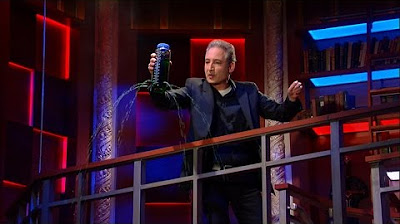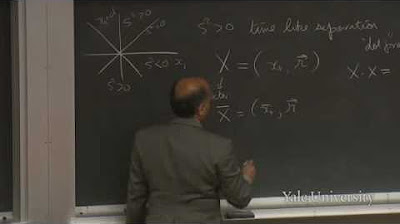Theoretical Physicist Brian Greene Explains Time in 5 Levels of Difficulty | WIRED
TLDRIn an engaging discussion spanning five levels of complexity, physicist Brian Greene elucidates the nature of time. Beginning with a child's perspective, he explains time dilation from special relativity and the asymmetry between past and future. Through conversations with students, he examines entropy, causality, the expansion of space, and the possibility of time travel, highlighting the counterintuitive effects implied by general relativity. Greene emphasizes time's subtleties while finding solace in the eternal existence of moments in spacetime, concluding that appreciating time's richness can enhance our brief flicker of existence.
Takeaways
- 😲 Time is connected to motion and change, yet we move freely through space but not time.
- 😎 Einstein showed time passes slower for moving clocks compared to stationary ones.
- 🤔 The arrow of time likely emerges from increasing disorder, yet its exact origin remains unclear.
- 🔭 Experiencing time is subjective, yet physics reveals an underlying objective description.
- ⌛ Space provides the 'where', time provides the 'when'.
- ⏳ Closed timelike loops in wormholes theoretically allow time travel, but raise paradoxes.
- 🕰 General relativity proves gravity slows clocks - essential for GPS satellites to work.
- 🤯 Basic algebra shows time runs slower for moving clocks based only on fixed speed of light.
- 😴 From the cosmic perspective humanity blinks briefly into existence within two eternities.
- 💡 Space and time may be emergent properties arising from an as yet unknown description.
Q & A
What is the relationship between motion through space and the passage of time?
-They are connected - as objects move through space, time elapses. Einstein showed that clocks on a fast moving spaceship tick off time more slowly compared to clocks on Earth.
Can we travel to the future in principle according to current physics theories?
-Yes, through relativistic time dilation - a fast moving clock ticks off time more slowly compared to one at rest. By traveling close to the speed of light, less time would elapse for the traveler compared to observers on Earth.
What is entropy in physics and how is it related to the arrow of time?
-Entropy is a measure of disorder in a system. The second law of thermodynamics states that entropy tends to increase towards the future, giving a directionality or 'arrow' to time.
Could wormholes act as time machines according to current theories?
-Possibly - wormholes are shortcuts through spacetime. If the openings move at different speeds, time could elapse differently at each opening, allowing travel to the past or future.
What is meant when physics theories treat past and future on an equal footing mathematically?
-The fundamental equations make no distinction between positive and negative time coordinate values - yet we perceive time as having a directionality or 'arrow'.
In the 'twin paradox', who ages more - the Earth-bound twin or the space traveling twin? Why?
-The space traveling twin ages less due to relativistic time dilation from their motion. When they reunite, the Earth-bound twin is older.
Can we ever have a real-time conversation with extraterrestrial life very far away?
-Possibly, if we lived in a universe with compact spatial dimensions. Signals could travel vast distances and return quickly along the compact dimension.
What does physics say about whether the past persists and always exists?
-Relativity suggests all moments coexist eternally along the time dimension, much as we accept all points exist eternally along spatial dimensions.
Who first introduced quantitative and mathematical descriptions of nature?
-Galileo and Newton pioneered the quantitative, mathematical description of physical processes, enabling later breakthroughs like relativity.
Could space and time be emergent properties arising from an underlying non-spatiotemporal theory?
-Possibly, but we don't yet have concrete models of emergence. Understanding this would constitute a major revolution in physics on par with relativity and quantum mechanics.
Outlines
😀 Introducing the topic of time and distinguishing space from time
The paragraph introduces the topic of time as the most familiar yet mysterious quality of the physical universe. It makes a key distinction between space and time - we can move freely through space but not time. It mentions Einstein's theory to travel to the future by approaching the speed of light, though it's unclear if we can travel to the past.
😊 Using high school math to derive time dilation
The paragraph shows how with basic high school algebra and trigonometry, Einstein's equation for time dilation can be derived based on the constant speed of light. It illustrates this graphically using a light clock in motion to trace out a longer path. As speed approaches light speed, time slows down dramatically for the moving clock.
😕 Discussing the arrow of time and order emerging from disorder
This paragraph discusses the arrow of time and the tendency for entropy or disorder to increase towards the future based on statistical principles. It touches on the paradox of how order emerges from disorder, tracing back to the highly ordered beginnings in the Big Bang. An explanation for the arrow of time remains elusive.
🤔 Pondering deep questions on time travel and determinism
The paragraph discusses imaginative ideas like wormholes allowing time travel, which raises paradoxes. It mentions different resolutions like parallel worlds or laws of physics preventing changes to the past. An unsettled discussion on whether the laws of physics fundamentally prevent traveling to the past or if it's just fears of paradoxes.
🧐 Defining time and distinguishing space-time experience
This attempts to define time simply as a parameter measured by clocks, that allows description of change through equations and encodes causality. It distinguishes space-time as a mathematical construct from subjective human experience, touching on entropy and disorder as a macroscopic arrow of time.
😮 Discovering unexpected space-time behavior
The paragraph discusses a recent paper showing how in a circular spatial dimension, an observer can send signals far back in time without violating causality, facilitating instant communication over vast distances. This surprises even experts, showing space-time has unforeseen consequences even in simple settings.
😌 Finding solace in the permanence of moments in space-time
As a conclusion, the paragraph notes how relativity blurs distinctions between space and time, leading some to see all moments as permanently existing. This idea that all instances always remain can provide solace about mortality, much like all spatial points exist.
Mindmap
Keywords
💡time
💡future
💡arrow of time
💡entropy
💡causality
💡wormhole
💡paradox
💡beginning
💡end
💡reality
Highlights
The relationship between motion through space and the passage of time
Traveling close to the speed of light allows you to travel far into the future
There is an arrow of time that points from past to future
Entropy tends to increase towards the future
Order and disorder don't apply as much to single particles
GPS accounting for relativity keeps the system accurate
Wormholes allow for time travel paradoxes
Laws of physics treat past and future symmetrically mathematically
Space expanding is compatible with our understanding of forces
Looking at other galaxies shows what happened in their past
Who ages less in the twin paradox is broken by having one twin accelerate
A curled extra dimension allows sending signals to the past without violating causality
Even settled ideas about relativity have surprises
Space and time may be emergent, not fundamental
Quantitative understanding is the greatest revolution in science
Transcripts
Browse More Related Video

Time Travel For Real This Time with Brian Greene & Neil deGrasse Tyson

Brian Greene Explains That Whole General Relativity Thing

What is a ‘Cause,’ and Why Does it Happen Before the Effect? Carlo Rovelli

The “afterlife” according to Einstein’s special relativity | Sabine Hossenfelder

How Can SPACE and TIME be part of the SAME THING?

14. Introduction to the Four-Vector
5.0 / 5 (0 votes)
Thanks for rating: